Case Study: Competitive Environment and Opportunities in Casino Market
VerifiedAdded on 2023/04/23
|8
|1061
|413
Case Study
AI Summary
This case study provides an overview of the casino industry, starting with its historical roots and evolution into a global phenomenon. It examines the core business activities and structure of the industry, highlighting the impact of changes on U.S. casinos. The analysis delves into the evolving trends, including shifts in consumer gambling habits, marketing strategies, and technological advancements, and their effect on the competitive landscape for existing casinos. Furthermore, the study explores the opportunities these trends create for new entrants in the casino market, such as online services and tribal gaming. The study references various sources to support its analysis of the casino industry's dynamics and future prospects.

History of Casinos
Paraphrase This Document
Need a fresh take? Get an instant paraphrase of this document with our AI Paraphraser

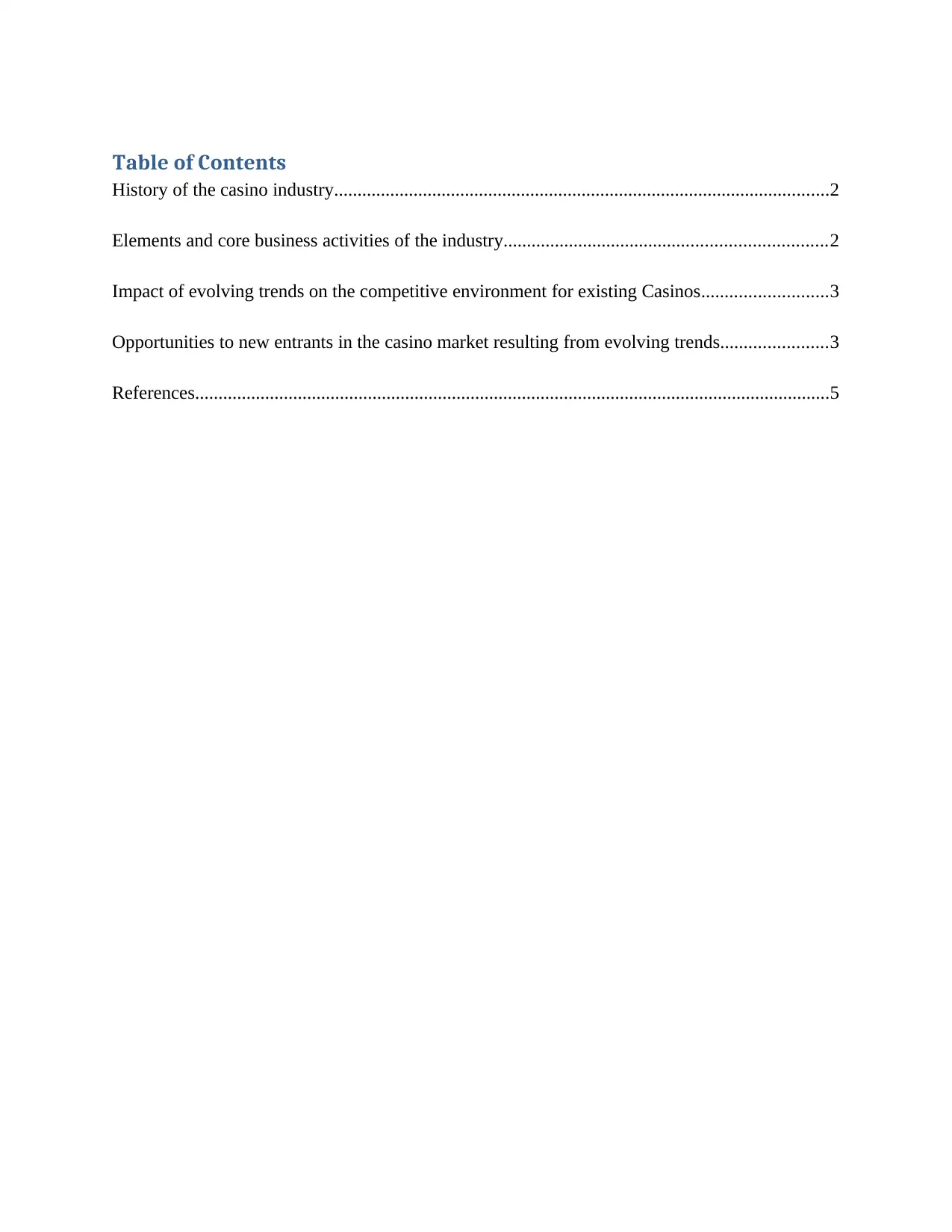
Table of Contents
History of the casino industry..........................................................................................................2
Elements and core business activities of the industry.....................................................................2
Impact of evolving trends on the competitive environment for existing Casinos...........................3
Opportunities to new entrants in the casino market resulting from evolving trends.......................3
References........................................................................................................................................5
History of the casino industry..........................................................................................................2
Elements and core business activities of the industry.....................................................................2
Impact of evolving trends on the competitive environment for existing Casinos...........................3
Opportunities to new entrants in the casino market resulting from evolving trends.......................3
References........................................................................................................................................5
⊘ This is a preview!⊘
Do you want full access?
Subscribe today to unlock all pages.

Trusted by 1+ million students worldwide
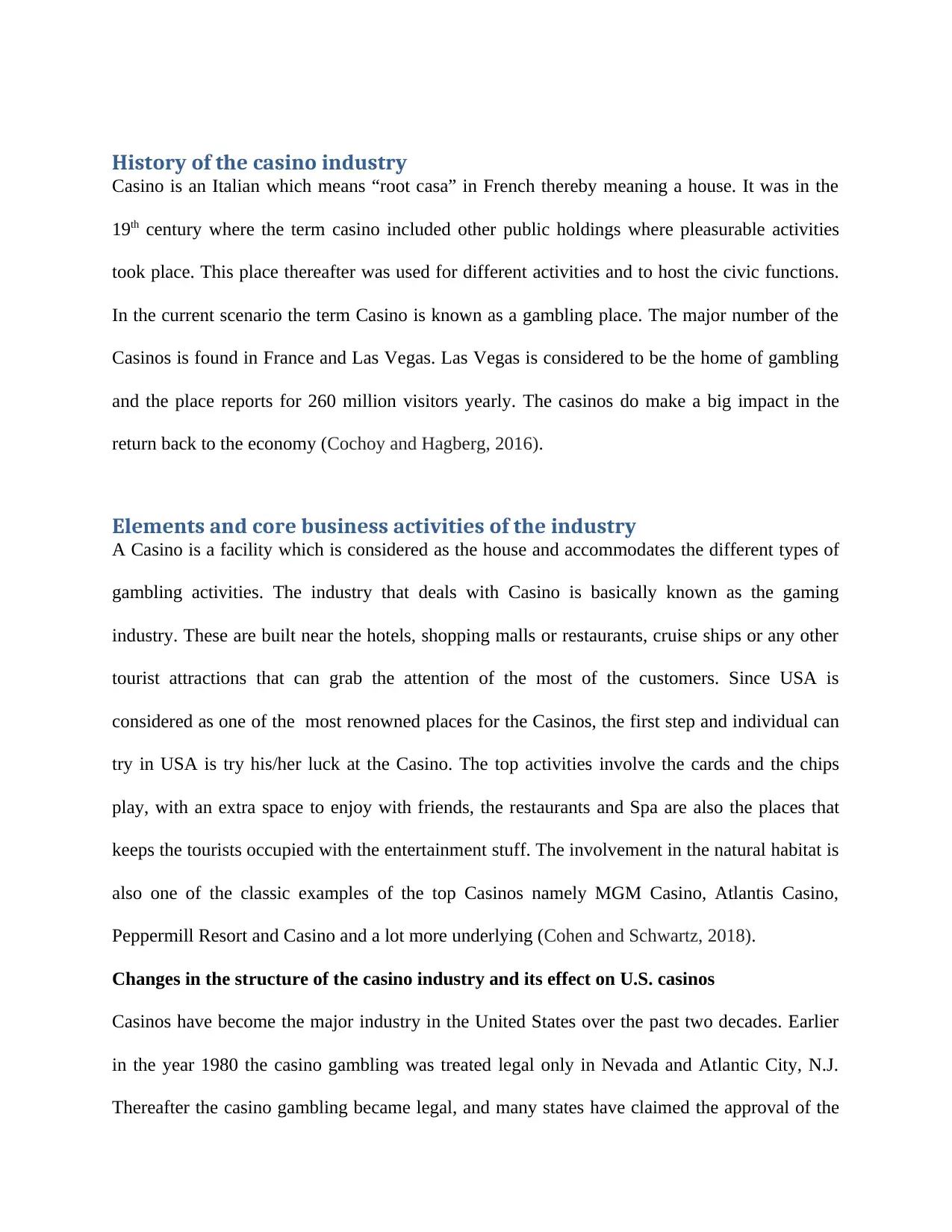
History of the casino industry
Casino is an Italian which means “root casa” in French thereby meaning a house. It was in the
19th century where the term casino included other public holdings where pleasurable activities
took place. This place thereafter was used for different activities and to host the civic functions.
In the current scenario the term Casino is known as a gambling place. The major number of the
Casinos is found in France and Las Vegas. Las Vegas is considered to be the home of gambling
and the place reports for 260 million visitors yearly. The casinos do make a big impact in the
return back to the economy (Cochoy and Hagberg, 2016).
Elements and core business activities of the industry
A Casino is a facility which is considered as the house and accommodates the different types of
gambling activities. The industry that deals with Casino is basically known as the gaming
industry. These are built near the hotels, shopping malls or restaurants, cruise ships or any other
tourist attractions that can grab the attention of the most of the customers. Since USA is
considered as one of the most renowned places for the Casinos, the first step and individual can
try in USA is try his/her luck at the Casino. The top activities involve the cards and the chips
play, with an extra space to enjoy with friends, the restaurants and Spa are also the places that
keeps the tourists occupied with the entertainment stuff. The involvement in the natural habitat is
also one of the classic examples of the top Casinos namely MGM Casino, Atlantis Casino,
Peppermill Resort and Casino and a lot more underlying (Cohen and Schwartz, 2018).
Changes in the structure of the casino industry and its effect on U.S. casinos
Casinos have become the major industry in the United States over the past two decades. Earlier
in the year 1980 the casino gambling was treated legal only in Nevada and Atlantic City, N.J.
Thereafter the casino gambling became legal, and many states have claimed the approval of the
Casino is an Italian which means “root casa” in French thereby meaning a house. It was in the
19th century where the term casino included other public holdings where pleasurable activities
took place. This place thereafter was used for different activities and to host the civic functions.
In the current scenario the term Casino is known as a gambling place. The major number of the
Casinos is found in France and Las Vegas. Las Vegas is considered to be the home of gambling
and the place reports for 260 million visitors yearly. The casinos do make a big impact in the
return back to the economy (Cochoy and Hagberg, 2016).
Elements and core business activities of the industry
A Casino is a facility which is considered as the house and accommodates the different types of
gambling activities. The industry that deals with Casino is basically known as the gaming
industry. These are built near the hotels, shopping malls or restaurants, cruise ships or any other
tourist attractions that can grab the attention of the most of the customers. Since USA is
considered as one of the most renowned places for the Casinos, the first step and individual can
try in USA is try his/her luck at the Casino. The top activities involve the cards and the chips
play, with an extra space to enjoy with friends, the restaurants and Spa are also the places that
keeps the tourists occupied with the entertainment stuff. The involvement in the natural habitat is
also one of the classic examples of the top Casinos namely MGM Casino, Atlantis Casino,
Peppermill Resort and Casino and a lot more underlying (Cohen and Schwartz, 2018).
Changes in the structure of the casino industry and its effect on U.S. casinos
Casinos have become the major industry in the United States over the past two decades. Earlier
in the year 1980 the casino gambling was treated legal only in Nevada and Atlantic City, N.J.
Thereafter the casino gambling became legal, and many states have claimed the approval of the
Paraphrase This Document
Need a fresh take? Get an instant paraphrase of this document with our AI Paraphraser
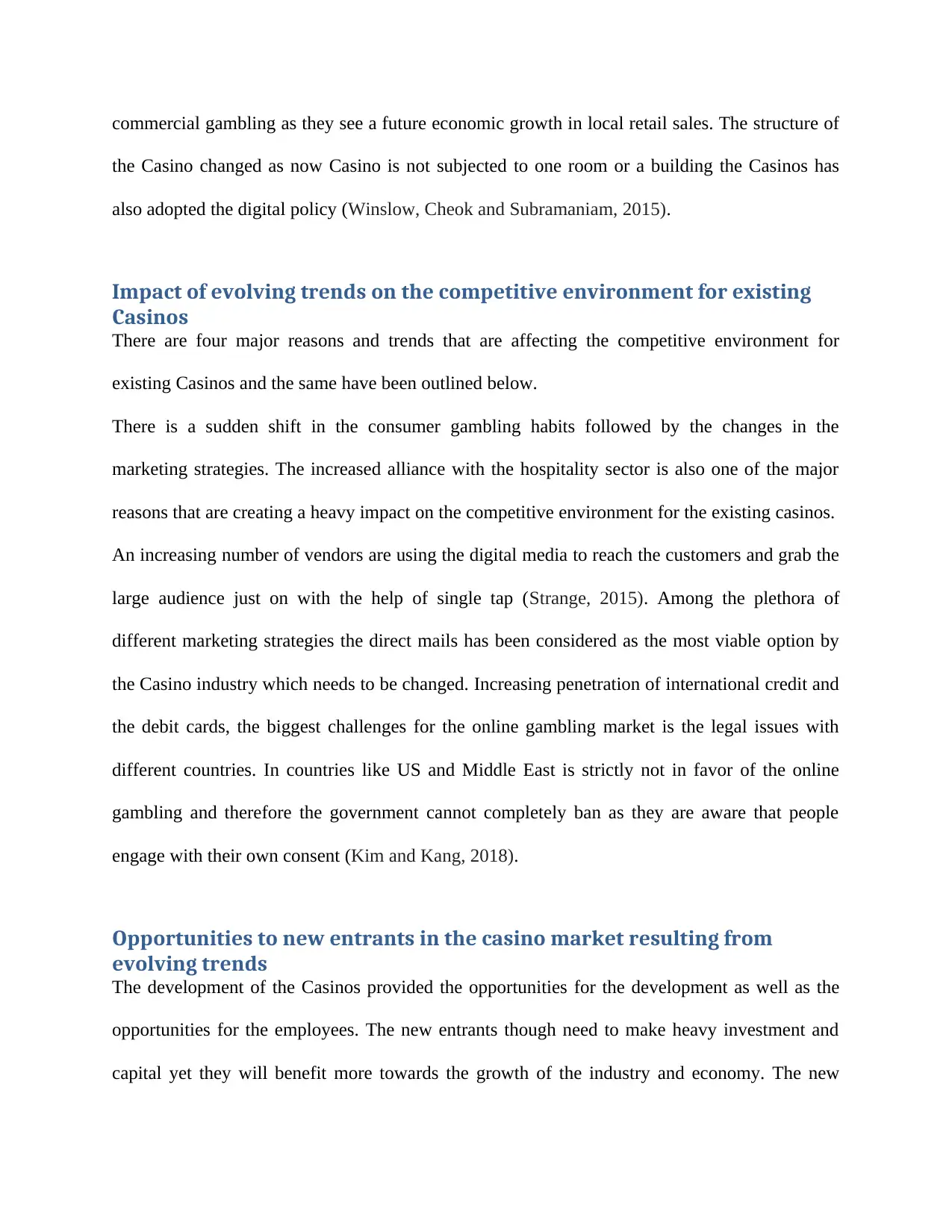
commercial gambling as they see a future economic growth in local retail sales. The structure of
the Casino changed as now Casino is not subjected to one room or a building the Casinos has
also adopted the digital policy (Winslow, Cheok and Subramaniam, 2015).
Impact of evolving trends on the competitive environment for existing
Casinos
There are four major reasons and trends that are affecting the competitive environment for
existing Casinos and the same have been outlined below.
There is a sudden shift in the consumer gambling habits followed by the changes in the
marketing strategies. The increased alliance with the hospitality sector is also one of the major
reasons that are creating a heavy impact on the competitive environment for the existing casinos.
An increasing number of vendors are using the digital media to reach the customers and grab the
large audience just on with the help of single tap (Strange, 2015). Among the plethora of
different marketing strategies the direct mails has been considered as the most viable option by
the Casino industry which needs to be changed. Increasing penetration of international credit and
the debit cards, the biggest challenges for the online gambling market is the legal issues with
different countries. In countries like US and Middle East is strictly not in favor of the online
gambling and therefore the government cannot completely ban as they are aware that people
engage with their own consent (Kim and Kang, 2018).
Opportunities to new entrants in the casino market resulting from
evolving trends
The development of the Casinos provided the opportunities for the development as well as the
opportunities for the employees. The new entrants though need to make heavy investment and
capital yet they will benefit more towards the growth of the industry and economy. The new
the Casino changed as now Casino is not subjected to one room or a building the Casinos has
also adopted the digital policy (Winslow, Cheok and Subramaniam, 2015).
Impact of evolving trends on the competitive environment for existing
Casinos
There are four major reasons and trends that are affecting the competitive environment for
existing Casinos and the same have been outlined below.
There is a sudden shift in the consumer gambling habits followed by the changes in the
marketing strategies. The increased alliance with the hospitality sector is also one of the major
reasons that are creating a heavy impact on the competitive environment for the existing casinos.
An increasing number of vendors are using the digital media to reach the customers and grab the
large audience just on with the help of single tap (Strange, 2015). Among the plethora of
different marketing strategies the direct mails has been considered as the most viable option by
the Casino industry which needs to be changed. Increasing penetration of international credit and
the debit cards, the biggest challenges for the online gambling market is the legal issues with
different countries. In countries like US and Middle East is strictly not in favor of the online
gambling and therefore the government cannot completely ban as they are aware that people
engage with their own consent (Kim and Kang, 2018).
Opportunities to new entrants in the casino market resulting from
evolving trends
The development of the Casinos provided the opportunities for the development as well as the
opportunities for the employees. The new entrants though need to make heavy investment and
capital yet they will benefit more towards the growth of the industry and economy. The new
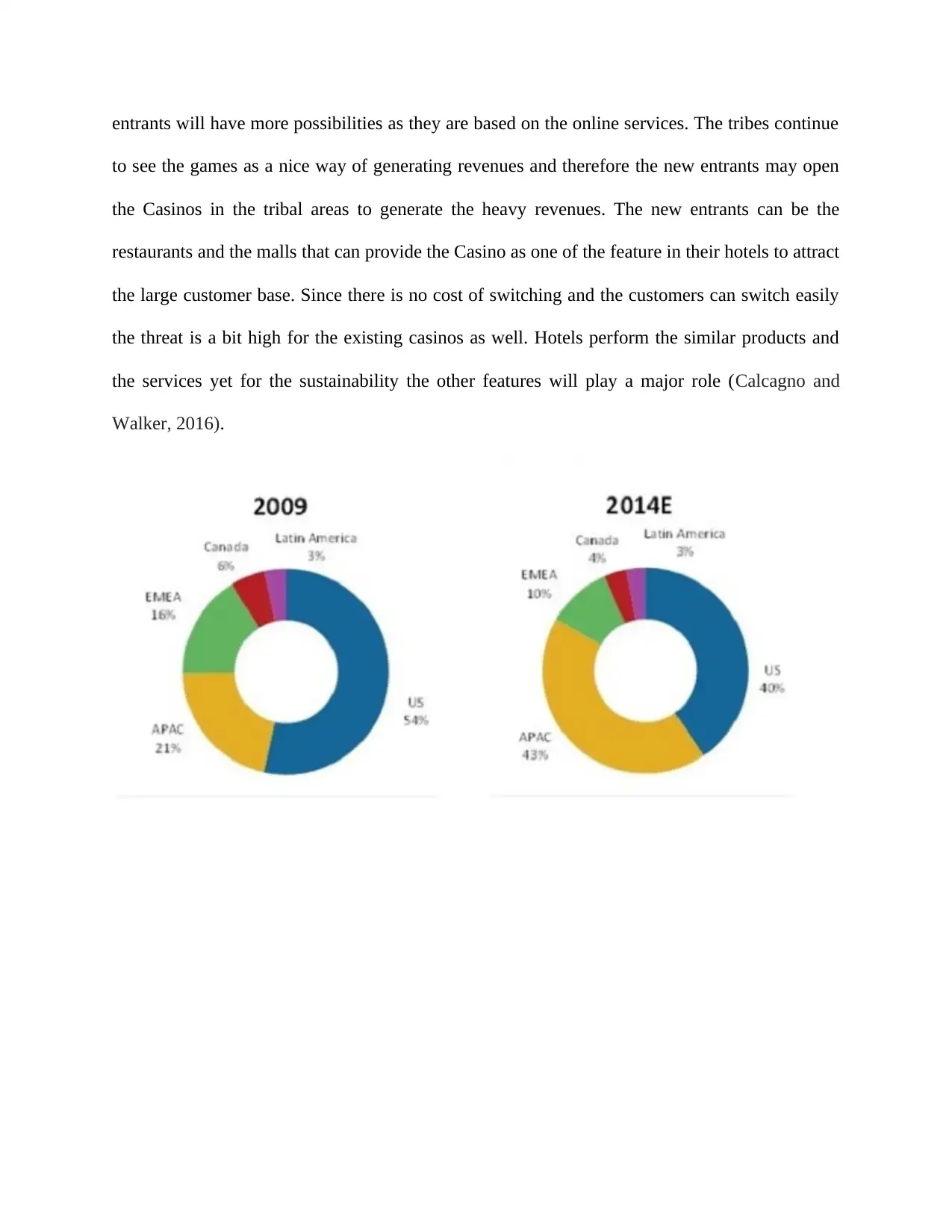
entrants will have more possibilities as they are based on the online services. The tribes continue
to see the games as a nice way of generating revenues and therefore the new entrants may open
the Casinos in the tribal areas to generate the heavy revenues. The new entrants can be the
restaurants and the malls that can provide the Casino as one of the feature in their hotels to attract
the large customer base. Since there is no cost of switching and the customers can switch easily
the threat is a bit high for the existing casinos as well. Hotels perform the similar products and
the services yet for the sustainability the other features will play a major role (Calcagno and
Walker, 2016).
to see the games as a nice way of generating revenues and therefore the new entrants may open
the Casinos in the tribal areas to generate the heavy revenues. The new entrants can be the
restaurants and the malls that can provide the Casino as one of the feature in their hotels to attract
the large customer base. Since there is no cost of switching and the customers can switch easily
the threat is a bit high for the existing casinos as well. Hotels perform the similar products and
the services yet for the sustainability the other features will play a major role (Calcagno and
Walker, 2016).
⊘ This is a preview!⊘
Do you want full access?
Subscribe today to unlock all pages.

Trusted by 1+ million students worldwide
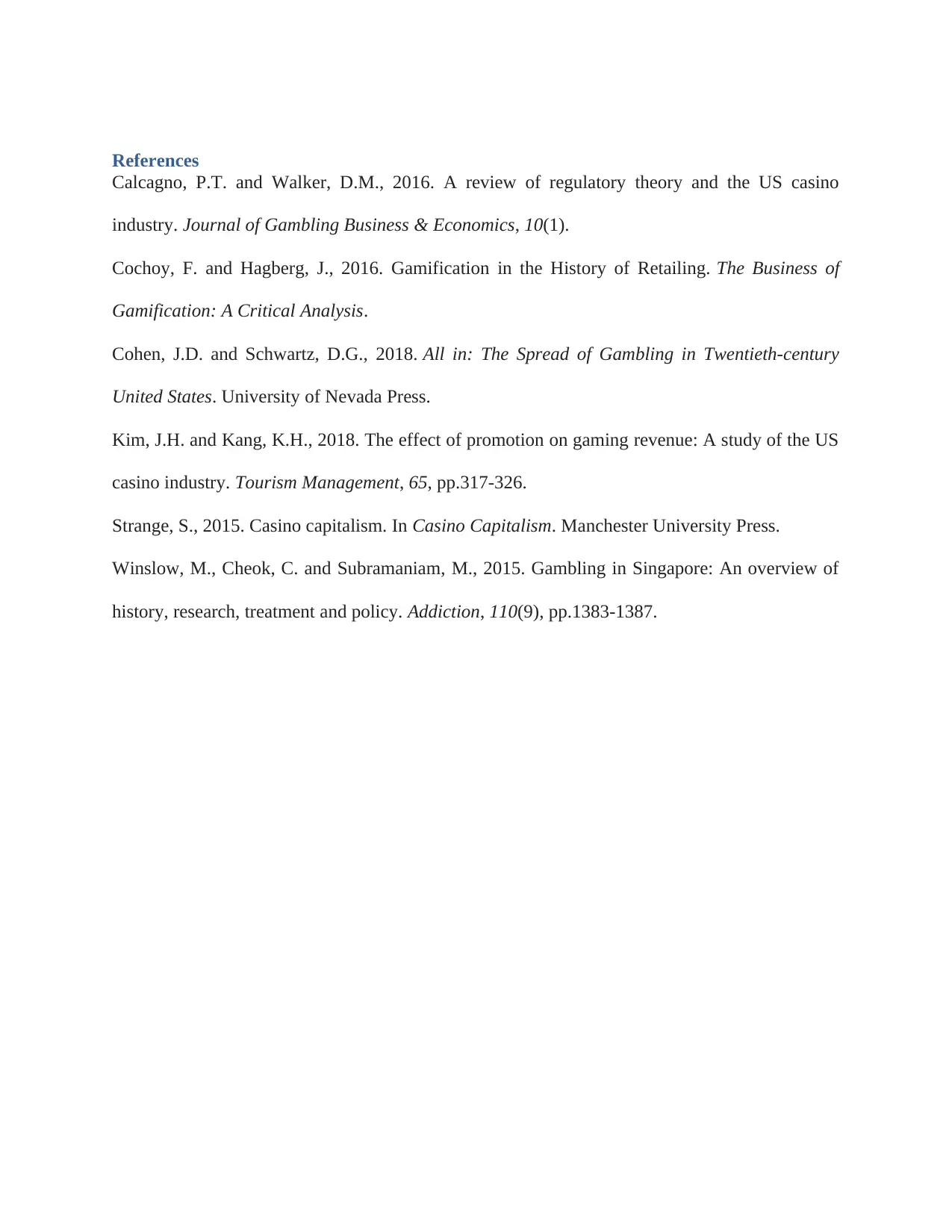
References
Calcagno, P.T. and Walker, D.M., 2016. A review of regulatory theory and the US casino
industry. Journal of Gambling Business & Economics, 10(1).
Cochoy, F. and Hagberg, J., 2016. Gamification in the History of Retailing. The Business of
Gamification: A Critical Analysis.
Cohen, J.D. and Schwartz, D.G., 2018. All in: The Spread of Gambling in Twentieth-century
United States. University of Nevada Press.
Kim, J.H. and Kang, K.H., 2018. The effect of promotion on gaming revenue: A study of the US
casino industry. Tourism Management, 65, pp.317-326.
Strange, S., 2015. Casino capitalism. In Casino Capitalism. Manchester University Press.
Winslow, M., Cheok, C. and Subramaniam, M., 2015. Gambling in Singapore: An overview of
history, research, treatment and policy. Addiction, 110(9), pp.1383-1387.
Calcagno, P.T. and Walker, D.M., 2016. A review of regulatory theory and the US casino
industry. Journal of Gambling Business & Economics, 10(1).
Cochoy, F. and Hagberg, J., 2016. Gamification in the History of Retailing. The Business of
Gamification: A Critical Analysis.
Cohen, J.D. and Schwartz, D.G., 2018. All in: The Spread of Gambling in Twentieth-century
United States. University of Nevada Press.
Kim, J.H. and Kang, K.H., 2018. The effect of promotion on gaming revenue: A study of the US
casino industry. Tourism Management, 65, pp.317-326.
Strange, S., 2015. Casino capitalism. In Casino Capitalism. Manchester University Press.
Winslow, M., Cheok, C. and Subramaniam, M., 2015. Gambling in Singapore: An overview of
history, research, treatment and policy. Addiction, 110(9), pp.1383-1387.
Paraphrase This Document
Need a fresh take? Get an instant paraphrase of this document with our AI Paraphraser

1 out of 8
Related Documents
Your All-in-One AI-Powered Toolkit for Academic Success.
+13062052269
info@desklib.com
Available 24*7 on WhatsApp / Email
![[object Object]](/_next/static/media/star-bottom.7253800d.svg)
Unlock your academic potential
Copyright © 2020–2025 A2Z Services. All Rights Reserved. Developed and managed by ZUCOL.





